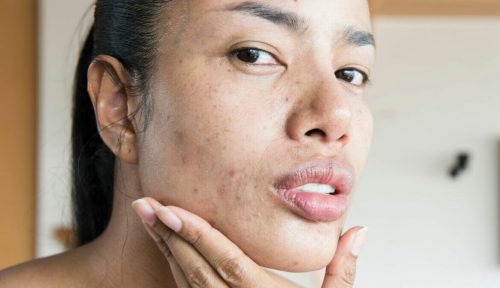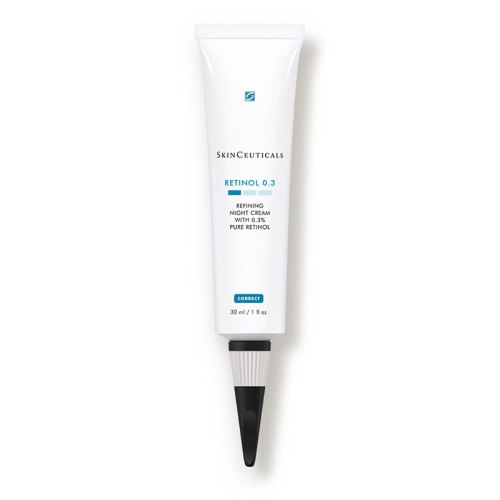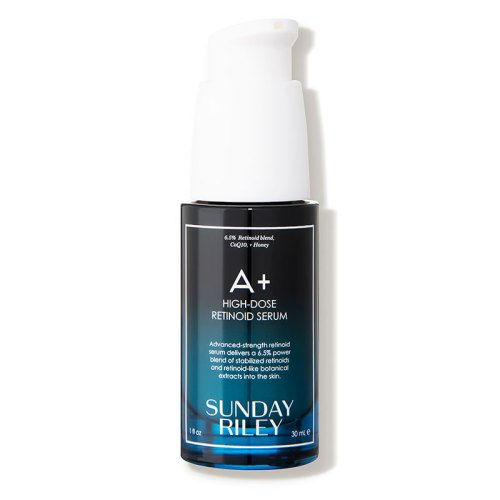Our editors independently select these products. Making a purchase through our links may earn Well+Good a commission
Retinol Purge 101: Everything a Dermatologist Wants You To Know
Dealing with skin purging? We asked three dermatologists to spill on everything you need to know about the "retinol uglies."

Retinol has become the gold standard for treating all sorts of skin conditions, from acne to signs of aging, but there’s one problem: In most cases, it makes things worse before it makes them better. Chances are if you’ve ever started on a new retinoid regimen you’re all too familiar with what beauty pros lovingly refer to as the “retinol uglies,” otherwise known as skin purging.
Experts in This Article
board-certified dermatologist in Northern California
New York City-based dermatologist and dermatologic surgeon
board-certified dermatologist at Medical Dermatology and Cosmetic Surgery in New York
board-certified dermatologist with Schweiger Dermatology Group
board-certified dermatologist in New York City
Retinol purging—which usually results in a wave of new pimples alongside peeling skin—is a common side effect of any new retinoid routine, but that doesn’t make it any less frustrating. Below, derms explain everything you need to know, and how to get through it without having to toss your retinol for good.
What is skin purging?
Retinol’s claim to fame is that it promotes cell turnover, which means that it brings new, healthy cells to the surface of your skin in order to replace old dead ones. But in the process, it also brings up all kinds of other stuff hiding under your skin, which may lead to sudden breakouts. “Skin purging happens when new ingredients, like retinol, promote increased cell turnover, which causes clogging and worsening breakouts. This is particularly the case as oil and debris that is trapped deeper underneath the skin comes to the surface,” explains board-certified dermatologist Michele J. Farber, MD, of Schweiger Dermatology Group.
So, for example, if you only had one or two pimples when you started on your retinoid, after continued, consistent use, that number may increase before ultimately decreasing for good. “It’s not that the retinol is making you break out more—it just brings pimples that a brewing below the surface to the surface all at once,” explains board-certified dermatologist Morgan Rabach, MD.
All skin types are prone to experiencing purging, but it may look different depending on where you fall on the dry-oily skin spectrum. “Skin on either extreme will be more likely to purge, as dry skin is more likely to get irritated and oily skin can have more clogging to clear with new products,” says Dr. Farber.
While retinol definitely gets a bad rap when it comes to skin purging, it’s not the only culprit. “Any ingredients that cause cell turnover can cause purging, and that includes exfoliant acids like alpha- and beta-hydroxy acids,” says Dr. Farber. Think: glycolic, lactic, and salicylic acids—all of which are common ingredients in acne treatments. In order to understand where your purge is coming from, be sure to add only one of these types of actives into your routine at a time.
How do you know if your skin is purging, breaking out, or having a reaction?
No matter what ingredient is behind your purge, the process tends to look the same. Think redness, new pimples, blackheads, and small bumps. According to Dr. Farber, it typically occurs in areas where you’re already experiencing a breakout under the surface. That said, it’s important to differentiate between a purge and a new, unrelated breakout. “A purge generally happens shortly after introducing a new acne ingredient, while a new breakout may occur with stress, your cycle, or introducing a new skin-care product like makeup, serum, or overly thick moisturizer,” says Dr. Farber. If it’s in new areas it’s more likely to be a new breakout, which means you’ll need to treat it differently.
And if you rarely deal with pimples but are suddenly breaking out after introducing a new product, it may not actually be purging at all. Cell turnover aside, it could mean that the product formulation simply isn’t right for your skin. “If you break out after using a product and you don’t typically have acne-prone skin, then it may indicate that the product is too heavy for your skin,” says board-certified dermatologist Jennifer Chwalek, MD. She suggests checking the ingredient list to see if it contains things like mineral oil, coconut oil, silicones, or lanolin, which could be clogging your pores while the retinol is trying to clear them.
It’s also important to understand the difference between “purging” and a full-blown reaction—which will leave your skin red, burning, and peeling. “If you are having any skin reaction you should stop all of your skin-care products and use only a gentle, non-fragranced cleanser and moisturizer,” says Dr. Chwelak. “Once the irritation or breakout has cleared and your skin is back to baseline, you can restart your products slowly, one at a time over the course of a few weeks.”
How to deal with skin purging
While purging might be inevitable, it doesn’t mean that you’re totally stuck. First things first, be sure to start slowly when introducing retinol into your routine—use a low-concentration formula once a week so that your skin can get used to it, and over time you can ramp things up to more frequent applications. Plus, be sure to moisturize. “A big mistake is people often do not moisturize when they feel that their skin is oily,” says Dr. Farber. “New acne products, they’re often drying and you’ll keep breaking out if you don’t add in a moisturizer to repair the skin barrier.” She suggests using a light, oil-free moisturizer to keep things balanced.
If the irritation is unbearable, there are a few other tricks of the trade you can employ to make your retinol more tolerable. “Mix it with moisturizer, put it on and wash off, or decrease the concentration of retinol,” says Dr. Rabach. Other derms are a fan of the “retinol sandwich” method, which involves putting on moisturizer before and after your retinoid for an added layer of protection for your skin.
How long does retinol purging last?
While sudden breakouts from a product that’s meant to fight breakouts can feel like a major betrayal, it’s worth noting that it won’t last forever. According to Dr. Rabach, you should be in the clear after a week or two (and keep in mind that it usually takes two to three months for any new acne treatment to really start working its magic). That said, if you’re still getting irritation or clogging after three or four weeks, it may be time to chat with a derm to reevaluate your regimen. That’s because if your skin has gotten too irritated, it won’t be able to recover and thus adjust your new retinol if you keep slathering it on. “The challenge with applying an active ingredient when the skin is already compromised is you’re going to end up in this cycle where it becomes less and less easy to tolerate,” says Marisa Garshick, MD, a board-certified dermatologist in New York City.
General retinol tips to keep in mind as you adjust
1. Stick to a pea-sized amount
You never want to use too much retinol, but especially not in the beginning. It’s a waste of product and can also make it more irritating than necessary.
“There is a relationship between how much of the product is being applied to the skin and how potentially irritating it is,” says Dr. Garshick. “So if you use a lot of a retinoid in any given application, regardless of how tolerant your skin is of the retinoid, if you use a lot of it, it’s more likely to cause irritation.”
2. Adjust your usage with your environment and habits
Retinol is generally safe to use 365 days a year, but depending on your skin, environment, and habits, you may need to change your usage throughout the year.
“Even if you’ve been on a retinoid, let’s say, for years, and you generally tolerate it well, if you go on a trip, and you find the change in environment makes your skin a little bit more dry, you may get red or dry or itchy,” says Dr. Garshick. “It’s best to just skip a day or two to allow your skin to recover and then start again.”
Even if you’re in your normal environment, the change in seasons may make your skin more sensitive, whether it’s cold air drying, or increased sun exposure or laser treatment making your skin more sensitive. Listen to your skin and adjust your routine when needed.
3. Take your time
While it takes a few weeks to get through the purging, it’ll take a few more weeks to notice any benefit in your skin. If your skin is tolerating it, stick with it for about two months to see if it’s making a difference.
“Retinoids work by binding to and turning on receptors in the skin called retinoic acid receptors that then impact how the skin behaves,” says Caren Campbell, MD, a board-certified dermatologist practicing in Napa and San Fransico, Califonia. “It takes time for these changes to begin and impact the way the skin is behaving, which is why retinoids take time to work, on average, six weeks for acne and six-plus months for anti-aging.”
4. Remember that you don’t have to use retinol
Retinol is a great ingredient, but if you’ve given it a go for over three weeks, are using a low concentration, and still feel irritated, it may not be for you and that’s okay.
“If you do introduce something, and you find your skin immediately either burns or stings, or the next day you experience redness or dryness or flaking, or you just feel like your skin is developing some kind of reaction, it may seem as though you’re probably not meant for that ingredient,” says Dr. Garshick. “Not all ingredients have to be used on all skin types.”
3 retinol serums to try

SkinMedica Age Defense Retinol Complex 1.0 — $96.00

SkinCeuticals Retinol 0.3 — $70.00

Sunday Riley A+ High-Dose Retinoid Serum — $43.00 to $122.00
Got more questions about retinol? Allow board-certified dermatologist Mona Gohara, MD, to answer them for you:
Sign up for the Well+Good SHOP Newsletter
Get exclusive deals on wellness, beauty, fitness, and food products that have been hand-picked by our editors.
Got it, you've been added to our email list.










